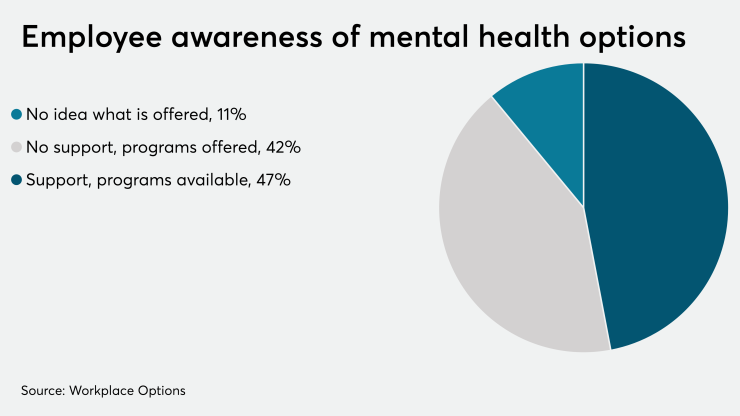Mental health concerns have become a top priority for employers over the last few years and with good reason. Conditions such as anxiety and depression can cost the global economy $1 trillion each year in lost productivity, according to the World Health Organization.
When an employee is suffering from a mental health disorder in addition to another illness, the direct cost of the other health conditions can run three times as much on average, per data from Milliman. In fact, less than 20% of the costs of mental illness are reflected in the direct costs of treatment, according to the World Economic Forum. To make matters worse, suicide rates have been climbing over the past decade and per the National Safety Council, the opioid epidemic is now the fastest growing health concern for many employers.
While employers have offered employee assistance program services for years and provide comprehensive mental health coverage in their benefit plans, WHO data found that only 60% of those who need help seek help. But it’s not all doom and gloom, as leading employers are addressing this issue and making progress. We can all learn from their progressive programs.
These employers are breaking the silence about mental health to improve acceptance, awareness and decrease stigma — which has also reinforced in a culture of caring and support. They are teaching employees skills to better manage emotional health, including resilience training, mindfulness and stress management. They are also helping to integrate with and connect their broader well-being strategies including physical, social, purpose, financial and community to holistically support mental health.
Connectivity to a community is a particularly important consideration as the overall health impact of loneliness and social isolation is on par with smoking 15 cigarettes a day.
Two examples of these programs are led by the Center for Workplace Mental Health. Developed in partnership with Employers Health, Right Direction is a turnkey customizable awareness initiative designed to demystify depression and encourage those who may be experiencing depression to seek help. Employers using Right Direction as part of their workplace mental health initiatives report increased EAP use and more openness around mental health issues at work.
The second effort designed to shine a light on mental health is the ICU Program. Dupont’s EAP developed ICU and the company delivered it to their 70,000 employees worldwide before donating it to the Center for Workplace Mental Health.
The developers designed ICU, with a 5-minute video as the centerpiece to reduce stigma and foster a workplace culture that supports employee mental health. Employers describe it as an important way to open conversations and normalize mental health in the workplace.
Programs such as these are instrumental in enhancing the work environment which plays a significant role in workforce health. The impact of stress on both physical and mental health is heavily influenced by the chronic exposure to unsustainable demands and pressures and can be disproportionately prevalent within different segments of the organization.
Supervisors should be trained on emotional intelligence as well as how to identify the early signs of concern and appropriately support individuals. Externally, employers are bringing more focus to their health plans or behavioral health carve outs to improve access to high quality and accessible services and ensuring that mental health screening and referral is integrated into primary care. Access is also being supplemented by non-traditional sources such as tele-behavioral health and technology-enabled cognitive behavioral therapy.
We are at a critical inflection point related to mental health. The cultural trends toward acceptance and personal engagement are continuously improving while the environmental factors related to the decline of social connection, increase in chronic stress and deteriorating access to affordable treatment are getting worse. No approach to population health can succeed holistically unless these issues are addressed head on.






